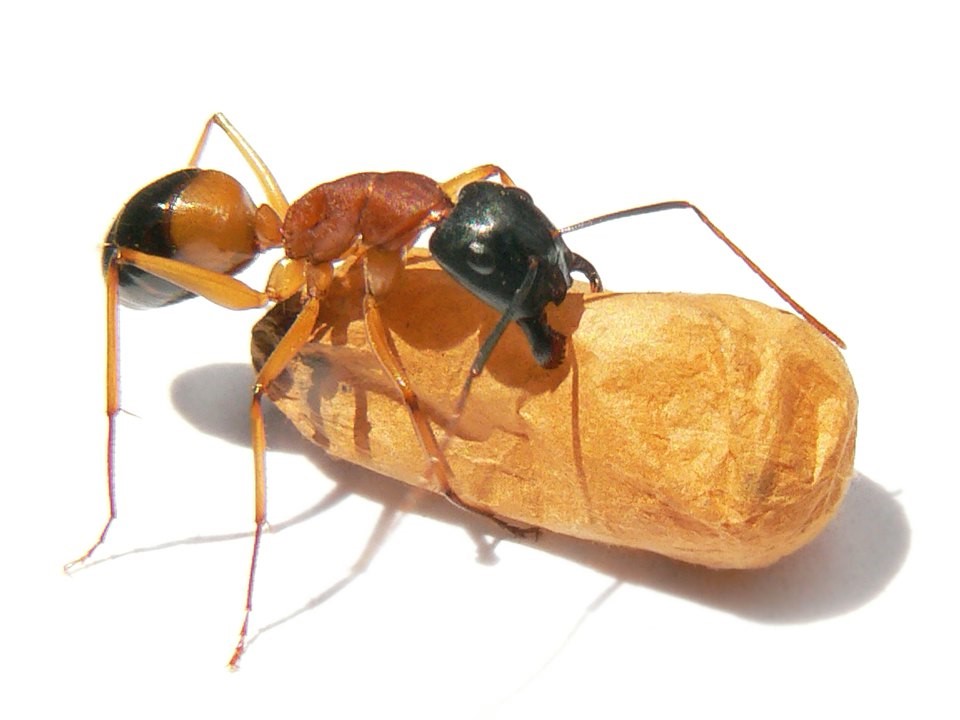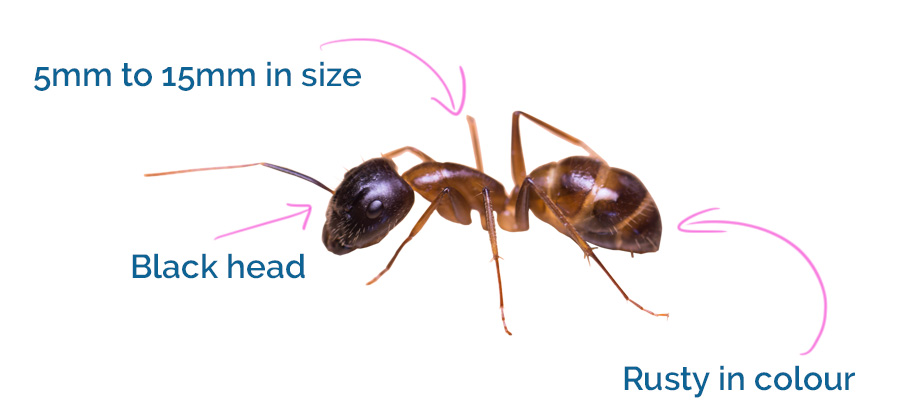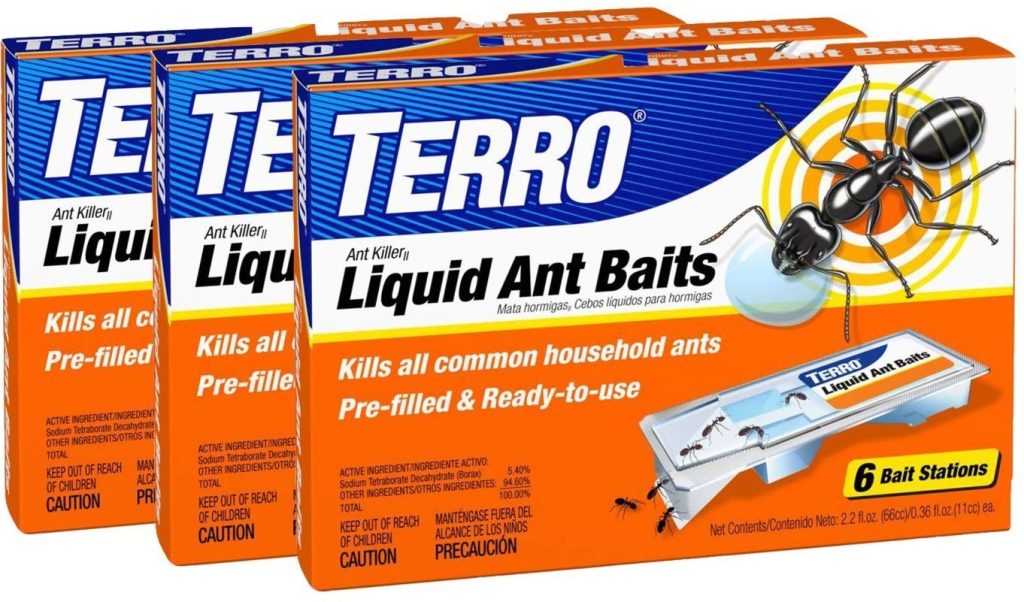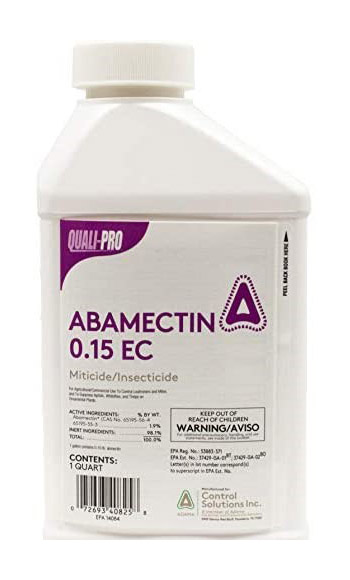Sugar Ants
Sugar Ants – What they look like, How you get them & How to get rid of them.
Campnotus Consobrinus
Facts, Identification & Control
The sugar ant, also known as banded sugar ant (Camponotus consobrinus) is a native species of ant from Australia. Its name refers to its liking for sugar and sweet food, and it also has this distinctive orange-and that wraps around its body. Sugar ants come in different colors, most likely due to ecological causes more than genetic. For example; temperature or humidity may affect the color of the sugar ant.

Campnotus Consobrinus 
Sugar Ant close up view

Identification & Characteristics
- Other Names: Banded Sugar Ant, Black-headed Sugar Ant
- Odor: Sugar Ants release a chemical smelling odor as a form of their defensive mechanism that sprayed from their anal glands
- Color: Black or Orange-Brown
- Size: 0.2 to 0.6 inches in length
- Legs: Six
- Antennae: Yes
- Shape: Oblong shaped thorax, with head just wider than the thorax punctuated obsoletely between the median ridges.

Habitat
They are nocturnal in nature and prefer a mesic habitat, where there is moderate or well-balanced supply of moisture. They also thrive in urban areas and are considered as pest. They are more active during the warmer seasons like the summer time. Inside the house, they are most commonly seen in:
- Kitchen counters and sinks where left-over food is usually found
- Cupboards with sweet food stocks
- Food pantries
- Walls & sidings
Outside the house, since they are mostly found in or around:
- Outdoor plant boxes
- Areas with loose soil
- Some forests & woodlands
- Grass lands & heaths
Sugar ants are one of the most widely distributed ants in Australia and is now found widespread throughout the USA.

Behavior
Sugar ants are mostly active at night, they thrive in moist environments and are strongly attracted to sweet substances, like nectar from plants, honeydew from aphids, maple syrup from your kitchen, and other nutrients high in carbohydrates. Hence their name; sugar ants. They also thrive in urban areas and are considered a pest.
These ants have multiple techniques to make other ants follow them to a food source, they can carry another worker going there or they can leave their pheromone trail on the way to the source. During food foraging or any other activity, when provoked, the ant will lift its abdomen and using its large mandibles, fends off an attacker or sprays formic acid to deter them.
Although they primarily eat sweets, sugar ants are omnivores and will also eat both plants and animals. They mostly feed on sweet substances. They have a beneficial, mutual relationship with aphids, plant-eating insects that secret sweet honeydew like substances from their anus, which they tend. As the ants protect aphids from attackers, aphids in turn provide them nutrition.

Reproduction
Sugar ants, like all other ants, begin their life cycle as eggs. They develop through metamorphosis and pass through a larval and then pupal stage before emerging as full-sized adult ants.
While most sugar ant colonies have been found to only have 1 queen, there have been cases where there were multiple queens. In colonies with multiple queens, free-mixing of offspring is observed. But despite this homogenous way of living, there have been observations where different family lineages are strongly related with the colonies’ caste system – making it seem that is indeed genetically determined. If there is only 1 queen, she will mate with only 1 male. These queens live for up to seven years or even longer.

Danger?
Sugar ants are harmless but considered a pest in the household. They can be seen at night occasionally and are capable of damaging house furniture and fittings. They chew on some wooden materials in the house.
Sugar ants are incapable of stinging humans. They are capable of biting and spray formic acid. The bigger ones like the soldier sugar ants can inflict minor pain when they bite, using their powerful jaws and by spraying the formic acid which can be corrosive to human skin. These bites can leave small red bumps and can cause further skin irritation, which if vigorously scratched and get exposed to bacteria, can lead to infection.

Signs of a Sugar Ant Infestation
If you suspect a sugar ant infestation, check your kitchen counter, pantry, container lids and cupboards. These ants are attracted to spills and crumbs, especially of sweet foods. The first sign would be seeing the worker ants, often at dusk, moving along trails searching for food. From the home, they return to their nests which usually look like dirt hills surrounded by small holes for entrances. These nests can be difficult to locate due to the sugar ants nocturnal behaviors.

Controlling Sugar Ants
Look for the path where ants are entering your house. You need to be able to pinpoint where the sugar ants are coming from. Most common points of entry are windows, doors, cracks, holes in the walls and floors. These ants also tend to nest in foliage or under trees, so clearing away any branches of trees or plants touching your house will help prevent them. Trim vines and bushes as these can become their bridge or highway in entering your house.
There are a few ways on how you can control them indoors, and the most common way for controlling sugar ants is luring them to traps and using sugar-based baits.

Total Control – Ant Kit
If you are looking for a single solution to permanently get rid of Sugar Ants indoors and out, then our Ant Kit is the way to go. It is set up to provide all the products and bait stations you need to treat any type of ant in the USA. You can read more about Ant Kits here, or if you want to purchase a kit now, simply click the button below:
DIY: Boric Acid and Honey. You can mix equal parts of honey and boric acid in a container. Stir until you get a paste-like consistency. Place the paste on a board, card board or any thick paper board. Place the board in the points of entry of the ants. Replace the traps every couple of days until you see no more sugar ants on the board.
Recommended Product: Duda Energy borp1 Fine Powder Boric Acid
Borax and Sugar. Mix 1 ½ tablespoons of Borax with 1 ½ cups of water and 0.5 cup of sugar. Dip cotton balls or cotton pads in the mixture until soaked. Put them on jar lids and place them on the pathways the ants are using from the entry point to poison them as soon as they come in contact with the solution.
Recommended Product: Mule Team All Natural Borax Detergent
You can also try using some other common substances in your kitchen to help drive them away:
White Vinegar. You can spray them with this solution. Add equal parts of vinegar and water and put it into a spray bottle. Spray the solution directly on the ants and places where they usually enter and forage for food as well as the trails they make. This will kill the ants and the pheromone traces as well, which will discourage them from returning.
Lemon Juice. Like vinegar, you can add 4 tablespoons of lemon juice to an 8-oz spray bottle. Spray the solution the same way as you would using the vinegar solution above.
Outdoor Control
Commercial Ant Baits and Sprays. After you have identified the entry points of the sugar ants, place ant baits near them. This will attract them soon and they will carry these to their nest which will kill the rest of their colony.
The sugar in the ant baits will lure them in. They end up eating the sugar and getting trapped at the same time or end up eating the chemicals in the bait as well. They may also bring the substance back to their nests and feed it to the rest of the colony.
Recommended Product: T T300B Liquid Ant Bait
Ant spray is also a popular method to get rid of sugar ants. The immediate effect is brought about by the droplet spraying of the insecticide. The main advantage is toxicity, so make sure to check that no animals and humans are near your target area for a few hours.
Recommended Product: Terro 16 oz. Aerosol Spray.

Best Products to Get Rid of Sugar Ants
Inside the House:
Luring sugar ants with ant baits is the most common and effective ways of controlling them. These baits must be put in places where you see ants often, such as kitchen spaces, trash cans, counters, table tops, cupboards and the likes.
Recommended Bait Types:

Sugar Based Bait:
Terro Liquid Ant Baits

Sugar Based Bait:
Harris Ant Killer Bait
Best Products for Outside the House:

Preventing Infestations
- Seal windows and doors. Make sure windows and doors are tightly sealed as sugar ants can enter the home through these openings. Also, seal holes and cracks on the walls and floors. This will help prevent infestation or re-infestation, especially after you have just gotten rid of them.
- Clean up every after meal. Keep your table tops, floors, kitchen counters clear of debris to prevent attracting sugar ants. Vacuum sweep and wipe food crumbs from these areas.
- Wash the dishes after a meal. Keep the kitchen sink and surrounding areas clean and dry. Dirty dishes, drinking glasses, food debris will surely attract sugar ants. If ever you are going to leave dishes in the sink, make sure that you rinse them.
- Take the trash out daily. Empty the garbage every day will help remove the possible sources of food waste that will attract sugar ants. Also, make sure that your trash bins are tightly sealed lids to help prevent sugar ants from getting in it.

Your Questions Answered
Now you should know how to detect sugar ant infestation and how to control it. If you have more questions left related to the topic, read this section to find answers.
1. Will Sugar Ants Go Away on Their Own?
If you see an army of ants in your kitchen, most likely they’re there for a reason. Ants search for food, and are attracted by spills, crumbs on the counter, uncovered fruits, and leftovers. Sugary foods work as a magnet for these creatures. Thus, the insects may go away on their own if the reason for their infestation is eliminated.
Contain all food to the fridge, cabinets, or under a cover, and clean your kitchen thoroughly. After a little while, there should be no ants left. Naturally, they will only go away until the next time you leave some food out.
2. Are Sugar Ants Active at Night?
Most ant species are nocturnal, so they’re most active during the night and sleep during the day. Sugar ants are no exception. They tend to wake up a couple of hours before the sunset and go into hiding around sunrise. The best time to lay bait and kill the whole ant colony is at night. However, individual ants can be spotted even at midday.
3. How Do You Find a Sugar Ants Nest?
Eliminating the whole colony is the best tactic against sugar ants. To do this, you have to find the sugar ant nest, which may be much more challenging than it first appears. Ants are tiny creatures that easily disappear into small areas, such as cracks between floorboards. Furthermore, ants rarely move in a straight line. Instead, they walk in zig-zags, making direction detection nearly impossible.
So, how do you find the ant nest? Firstly, don’t try to pursue a single insect. Wait until you spot a few, then you might have a chance to follow the way to their home. If you don’t succeed, search for clues of their presence. Check the most humid areas around pipes, kitchen sink, or backyard door. Finally, watch out for dead ants. They tend to die close to the nest, so piles of dead insects in a certain area may indicate their home.
If you still can’t track the ant nest, check the most common places of their habitat. These include areas around pet food and water bowls, cracks in walls and floor, air conditioning and heating units, trashcans, under the fridge, and insulation.
4. What Harm Do Sugar Ants Cause?
Sugar ants are generally considered harmless. After all, they’re tiny, aren’t venomous, and don’t damage your house, unlike some other ant species. This doesn’t mean they should peacefully walk around your house untouched, though, and we’ll explain why in a minute. The issues arising from sugar ants merely depend on their numbers.
Sugar ants may gnaw their way to food sources through plastic, cardboard, or paper. They can damage your storage containers, spill rice or milk, and cause other minor yet annoying inconveniences. Sugar ants may also contaminate your food and water, as they carry bacteria around the house with them.
Another issue with sugar ants is that they attract other insects, in particular spiders and centipedes. And, while some spiders help to get rid of flies and mosquitoes and are harmless, others may be dangerous. Centipedes are the kind of insect that should never get inside your house as the absolute majority of them are venomous.
Last but not least, although a sugar ant bite isn’t painful, it may cause allergy in individual cases.
5. How Do I Get Rid of Tiny Ants on My Kitchen Counter?
The first step in eliminating ants from your kitchen is finding the infestation reason. There should be a source they’re attracted to, usually bits of food or water left in easy access. Sometimes, ants may go away on their own if you clear the source, but this doesn’t always help.
If ants don’t seem to leave your house, you should spot their nest. We’ve explained how to do this a couple of questions earlier. Then, kill the whole ant colony by pouring special chemicals directly into the nest.
Even if you got rid of the nest, it’s highly unlikely that all ants were there at the time. Some may be still walking around your kitchen. You should clean it, particularly the counter, thoroughly. Wiping surfaces with a damp cloth won’t suffice. Start with changing and washing the trashcan. Afterward, use soap and water to clean your counter, table, and all cabinet shelves.
Spray surfaces with a mix of water and vinegar to disinfect them. This will also eliminate the ant’s sense of smell, causing them to lose the ant trail. Use the same solution to spray all potential ant entry routes. These include window and door frames and gaps in floors and walls. You may use specially designated liquid with a more pleasant smell for this purpose.
Lastly, check all your food containers, fridge, and other items in the kitchen for damage. If you notice ants have infested your food, we recommend throwing it away to avoid contamination. Plus, some ants may be still left inside.
6. How to Get Rid of Sugar Ants on Patio?
Sugar ants are attracted not only by food but also by water. Patios often get soaked in water from the lawn or may simply serve as a path to your kitchen. Either way, if you spot an ant colony at your patio, it’s worth getting rid of it.
Eliminating ants from a patio is relatively easy compared to getting them away from a kitchen. The only thing you should do is erase the ant trail. This can be done by spraying the patio with a chemical solution, vinegar, boric acid, and sugar, or washing it with dishwashing liquid. You can also try sugar ant traps that can be found in most gardening and DIY stores and contain poison.
Lastly, if neither of the mentioned options helps, call a pest control service on (888) 409-1728. Severe infestation with sugar ants may be extremely hard to get rid of, and professionals use ant control methods that aren’t available to regular consumers.





